Fiberboard is an indispensable material forcarrying out inexpensive repairs in an apartment or a private house. It is great for creating partitions, leveling the surface, providing sound insulation, etc. The only drawback of the wood board is its increased sensitivity to moisture, which significantly narrows the range of its use. In everyday life, many people are faced with the need to glue fiberboard with wallpaper. This raises the question: how to glue wallpaper on fiberboard correctly. This is what we will talk about further.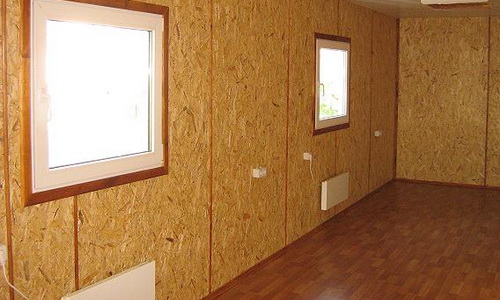 To reliably cover chipboard panels with wallpaper, their surface must first be treated.
To reliably cover chipboard panels with wallpaper, their surface must first be treated.
Preparatory work
To glue wallpaper onto fiberboard yourself, you may need the following tools and materials:
- roulette;
- roller;
- brush;
- a clip-on ruler;
- putty knife;
- scissors;
- pencil;
- primer;
- putty;
- glue;
- rags to remove excess glue.
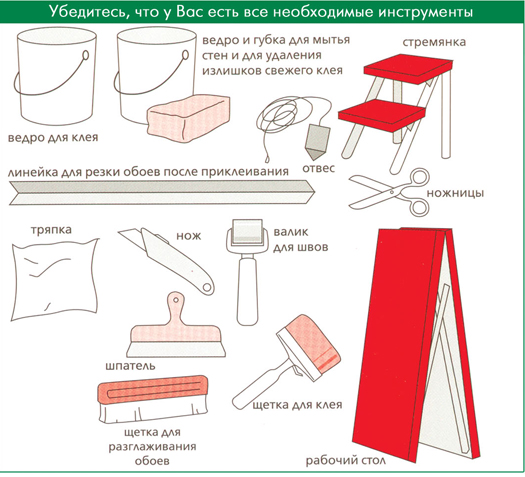 Tools and materials for wallpaperingChipboard. To prevent the pasted wallpaper from peeling off the base over time, it is necessary to carefully follow the entire technological process of finishing works, which includes the following stages:
Tools and materials for wallpaperingChipboard. To prevent the pasted wallpaper from peeling off the base over time, it is necessary to carefully follow the entire technological process of finishing works, which includes the following stages:
- dismantling of the old coating;
- priming of the base;
- putty;
- primer;
- wallpaper gluing;
- treatment of the coating with water-based varnish.
Before we move on directly tofinishing works, it is necessary to properly prepare the base. If the wood boards are finished with any material (old wallpaper, plaster, etc.), then it must be removed. After that, the surface is treated with a deep penetration primer. As a primer, you can choose an alkyd liquid or drying oil, because the wood board strongly absorbs moisture. If you do not pre-treat the surface, then a large amount of glue will be needed for reliable gluing of the wallpaper. At this stage, all joints of the boards are also processed, since otherwise, after finishing works are completed, traces of them may appear on the surface of the wallpaper.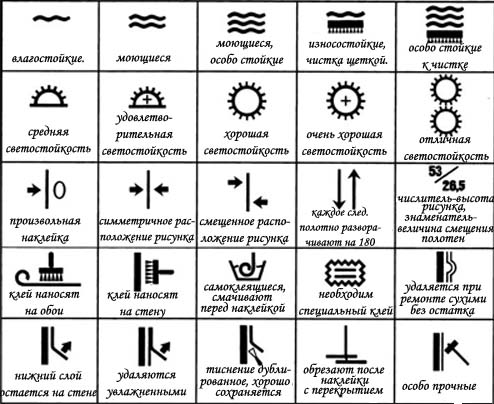 Symbols on wallpaper.After the primer has dried, you can move on to the next stage, that is, putty. It is used to eliminate small differences in height (up to 15 mm), dents, chips and other surface defects from the surface of the base. You can buy putty in the form of a ready-made mixture or dry powder. In the second case, before use, you will need to dilute it with water in the ratio indicated on the package. Putty is applied to the fiberboard in a thin layer, because if the layer is too thick, it can crack. If you need to eliminate significant irregularities, it is recommended to apply the mixture in several layers. The next layer can be applied only after the previous one has completely hardened. After the putty has dried, the base is primed again. This makes the surface of the boards as suitable as possible for pasting them with paper. Paper is glued so that the wallpaper sticks better to the wall. Return to the table of contents</a>
Symbols on wallpaper.After the primer has dried, you can move on to the next stage, that is, putty. It is used to eliminate small differences in height (up to 15 mm), dents, chips and other surface defects from the surface of the base. You can buy putty in the form of a ready-made mixture or dry powder. In the second case, before use, you will need to dilute it with water in the ratio indicated on the package. Putty is applied to the fiberboard in a thin layer, because if the layer is too thick, it can crack. If you need to eliminate significant irregularities, it is recommended to apply the mixture in several layers. The next layer can be applied only after the previous one has completely hardened. After the putty has dried, the base is primed again. This makes the surface of the boards as suitable as possible for pasting them with paper. Paper is glued so that the wallpaper sticks better to the wall. Return to the table of contents</a>
How to choose the glue for wallpaper?
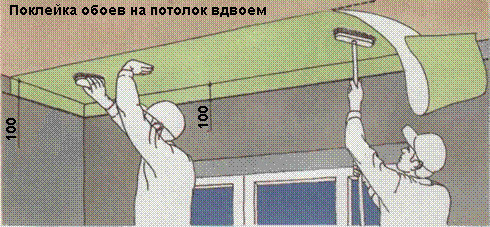 Wallpapering the ceiling together.The success of finishing works will directly depend on the quality of the adhesive mixture. When choosing the glue, first of all, you should start from the type of wallpaper. Any adhesive composition is perfect for paper wallpaper. For foamed, embossed and fabric wallpaper, it is recommended to use vinyl glue. It is very convenient, since sometimes during the work there is a need to fix something. With such glue it will be quite easy to do this: if necessary, the wallpaper can be torn off the wall and, having eliminated the defect, lay it again. In this case, there is no need to re-apply glue. In order to glue heavy wallpaper (vinyl or jute) with high quality, a special type of adhesive mixture is provided, which includes additives that prevent the occurrence of mold and mildew. Its only drawback is the high cost. For velor, textile and glass wallpaper, you can use a dispersion adhesive composition. Its main advantages are resistance to high humidity and high strength. Return to the table of contents</a>
Wallpapering the ceiling together.The success of finishing works will directly depend on the quality of the adhesive mixture. When choosing the glue, first of all, you should start from the type of wallpaper. Any adhesive composition is perfect for paper wallpaper. For foamed, embossed and fabric wallpaper, it is recommended to use vinyl glue. It is very convenient, since sometimes during the work there is a need to fix something. With such glue it will be quite easy to do this: if necessary, the wallpaper can be torn off the wall and, having eliminated the defect, lay it again. In this case, there is no need to re-apply glue. In order to glue heavy wallpaper (vinyl or jute) with high quality, a special type of adhesive mixture is provided, which includes additives that prevent the occurrence of mold and mildew. Its only drawback is the high cost. For velor, textile and glass wallpaper, you can use a dispersion adhesive composition. Its main advantages are resistance to high humidity and high strength. Return to the table of contents</a>
Fixing wallpaper on a fiberboard with your own hands
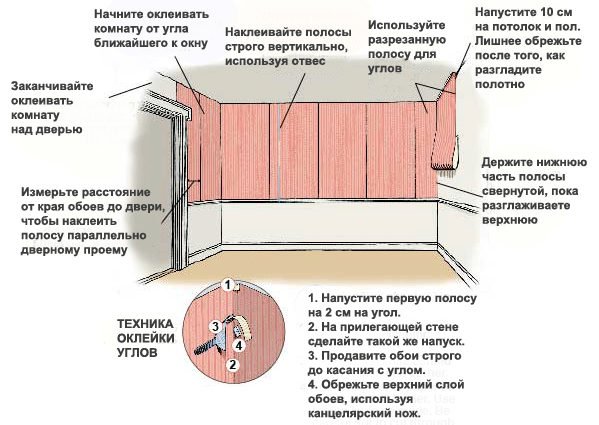 Wallpaper pasting technique.The technology of pasting fiberboard is practically no different from finishing a base made of another material with wallpaper. The glue must be applied not to the roll material, but to the base, that is, to the wood sheet. Due to the fact that this material strongly absorbs moisture, the glue is spread generously. The best option for such work is a universal adhesive mixture containing antifungal additives in its composition, with the help of which the wall will be reliably protected from fungus. It is recommended to take glue, like wallpaper, in reserve, because it is very difficult to guess exactly how much of it will be needed in this case. After completing all the work, the wallpaper will dry for 48 hours. During this time, the windows and doors in the room should be tightly closed to prevent drafts. Otherwise, the wallpaper may swell or peel off. After complete drying, to increase the service life of the wallpaper, they are covered with water-based varnish. Return to the table of contents</a>
Wallpaper pasting technique.The technology of pasting fiberboard is practically no different from finishing a base made of another material with wallpaper. The glue must be applied not to the roll material, but to the base, that is, to the wood sheet. Due to the fact that this material strongly absorbs moisture, the glue is spread generously. The best option for such work is a universal adhesive mixture containing antifungal additives in its composition, with the help of which the wall will be reliably protected from fungus. It is recommended to take glue, like wallpaper, in reserve, because it is very difficult to guess exactly how much of it will be needed in this case. After completing all the work, the wallpaper will dry for 48 hours. During this time, the windows and doors in the room should be tightly closed to prevent drafts. Otherwise, the wallpaper may swell or peel off. After complete drying, to increase the service life of the wallpaper, they are covered with water-based varnish. Return to the table of contents</a>
The main difficulties when wallpapering
Anyone who has ever encountered gluingwallpaper, knows what a difficult operation it is, taking a lot of time and effort. To make it easier, you can ask a friend to help you. The assistant will be able to hold the second part of the canvas and monitor the evenness of the gluing of the sheet. A rather labor-intensive operation is pasting the corners. Overlapping pasting is not suitable for finishing external corners. You will need to join several elements together, after which the resulting seam is covered with a corner or decorative strip. Internal corners are pasted with an overlap. In this case, it is recommended to use 2 canvases, because when finishing a corner with a single canvas, unevenness may form on its surface. It is worth noting that there is no universal technology for pasting wallpaper. It can change depending on the type of finishing material, the chosen color scheme, the presence of patterns, etc. Therefore, these works should be approached with all responsibility, taking into account all possible nuances.</ ul>


